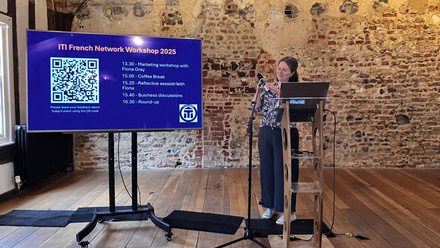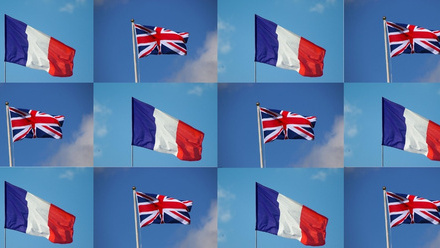From traceur to traducteur
Chris Vidler takes a break from vaulting and rolling to discuss translating the world of parkour
Translators spend a lot of our time sitting and staring at our computers. It’s therefore no surprise that many of us seek some form of release from this sedentary, screen-based profession. Among the colleagues I’ve met over the years, I’ve known many translators who are avid hikers and runners, with active pursuits that range from wild swimming to ceilidh dancing.
Me? Well, when I’m not trawling my way through technical documentation, I like to climb up onto ledges, balance on railings, vault over walls and roll out of drops onto concrete.
Parkour commonly gets associated with daredevil stunts, rooftop running and leaps of faith – but it’s not all about putting your life on the line in the name of YouTube clicks. In fact, there’s still plenty that you can do close to the ground, and the beauty of the sport is that you can scale the moves, routes and challenges that you attempt to your individual level of ability and experience.
I’m not just drawn to parkour because of the physical and mental benefits it offers, though – there’s also a wealth of history and culture behind the discipline to delve into, with a distinctly multilingual background to it.
One unit training together after dark
Although humans have been overcoming physical obstacles for millennia, modern-day parkour originated in the suburbs of Paris in the 1990s, pioneered by a group of young men who called themselves the Yamakasi – a word derived from the Lingala language meaning ‘strong spirit’. This group would train together after dark, scouring their urban environment for innovative ways to test themselves: crawling from one point to another on all fours, climbing the facades of buildings, or even traversing the edges of rooftops. And everyone would attempt the same challenges, starting and finishing their training together as one unit.
Thanks to their exploits, this extreme style of training caught on not only throughout France but also internationally. The 2003 documentary Jump London, which featured a group of French practitioners traversing their way across city landmarks such as the Southbank Centre and the Royal Albert Hall, helped bring parkour to the UK and establish a new generation of trainees here. The sport’s founding members have featured in plenty of other films too: David Belle starred in the parkour-driven Frenchlanguage action film District 13; Sébastien Foucan led Daniel Craig on a death-defying chase across cranes in the 2006 James Bond film Casino Royale; and the remainder of the Yamakasi showcased their abilities in a self-titled movie of their own.
With all those examples, there’s no doubt that parkour has strong visual appeal. But as a translator, I find it’s the language behind the sport that fascinates me most.
From the orphanage to the street (and above)
For starters, there’s the name of the discipline itself, which has sparked enough discussion alone to write an entire essay on it. It’s been known as ‘parkour’, ‘freerunning’, or even the lofty-sounding ‘l’art du déplacement’ (ADD, the ‘art of displacement’) – differences that arise largely from the backgrounds and interpretations of its various founders.
As French-speaking readers might have suspected, the name ‘parkour’ is derived from the French ‘parcours’. More specifically, it comes from ‘parcours du combatant’, meaning ‘obstacle course’ – a nod to the training activities David Belle’s father, Raymond, undertook during his time in a military orphanage. Raymond himself ultimately become a firefighter in Paris, in turn inspiring his son to develop his own abilities and style of parcours training.
‘Freerunning’, on the other hand, was the brainchild of Guillaume Pelletier, who helped to create the Jump London documentary. This term was definitely coined with localisation in mind, with the intention of establishing a new name for the sport within the Anglosphere. Sébastien Foucan later started using this term to describe his practice, taking it as an opportunity to broaden the kinds of movements it encompassed: whereas parkour placed emphasis on navigating one’s environment efficiently, freerunning would include greater scope for self-expression, with artistic elements such as flips, tricks and acrobatics.
For the most part, however, these names are used more or less interchangeably nowadays to refer to the same sorts of activities. Belle and Foucan ultimately went separate ways from the rest of the Yamakasi, but it’s still possible to train with some of the other original members of the group – who use the alternative moniker ‘l’art du déplacement’ – in the Parisian suburbs of Évry and Lisses, where the training style was first developed.
Following the traces to name the practitioners
So, whether we’re talking parkour, freerunning or ADD, how do we actually refer to someone who practises the sport? One term that’s commonly used (and spawned the idea for the title of this article) is ‘traceur’. Curiously enough, although this word looks French in origin – and even has a feminine form, ‘traceuse’, following the model of similar French words – it was actually devised by the early English-speaking proponents of the discipline. The word is derived from the name of another group of practitioners – Les Tracers – who came together following Belle’s departure from the Yamakasi. The English parkour community wanted to associate themselves with this new group, and so began calling themselves ‘traceurs’ – assuming, mistakenly, that the group’s original name in French included a ‘u’. The French practitioners turned out to be quite amused by this new term that their English counterparts had created – yet the name stuck, and has been used across both sides of the Channel ever since.
The term ‘traceur’ is still largely unfamiliar to those outside the sport, however, which poses certain considerations when translating materials for a general audience. I was once asked to prepare a document for translation from German outlining the schedule for a car company press conference. A highlight of the presentation would be a parkour display, whose performers were described as ‘parcoursläufer’. ‘Parkour runner’ would perhaps be the most literal translation from the German, but it’s not really how people doing parkour would describe themselves. The term used throughout this article, ‘parkour practitioner’, is one neutral-sounding alternative you could fall back on in such a situation. Of course, thanks to ‘freerunning’, ‘freerunner’ is also an option, and I believe that’s what my colleague who ultimately translated the text went with.
Tricks of terminology and translation
This is just one example that got me thinking early on about parkour in translation – and there’s no shortage of bilingualism when it comes to the actual techniques involved. Indeed, given its French roots and subsequent development in close collaboration with UK-based practitioners, there are French and English equivalent terms in existence for almost any parkour-related movement you can think of. You can get over a wall by vaulting (‘passement’) and disperse impact when you fall from a height by rolling (‘roulade’). Then there is the arm jump (‘saut de bras’): a jump in which you land against a wall hanging from the top ledge by your hands, in order to then pull yourself up. Perhaps most interestingly, any kind of movement that involves hanging off one horizontal object, such as a branch or bar, and moving through the air to hang off another such object by dropping or swinging is known as a ‘laché’ – derived from the French verb ‘lacher’, meaning ‘to let go’. It’s curious that the linguistic focus here is on releasing your grip, rather than catching and holding on!
There’s one technique that I’ve perpetually struggled with, where you run up to an obstacle and vault over it by placing both hands on the object, bringing both knees up and through the gap between your arms, and pushing off to propel your legs over and land on the other side. It’s called a ‘saut de chat’ in French, and is sometimes translated into English, with reference to the same animal, as a ‘cat pass’. When this move was introduced to the London parkour community, however, the English-speaking practitioners instead named it after a different animal, calling it the ‘monkey vault’. As they grew more competent, performing the move at greater speed and clearing larger obstacles, the name also grew accordingly: to describe these bigger vaults, a bigger monkey was needed, and hence it became known as a ‘King Kong vault’. This was eventually shortened to ‘kong vault’, and is used to describe all vaults of this kind today – even if you can’t quite propel yourself with the same power as the great ape.
Even from a monolingual perspective, parkour still remains a fascinating source of terminology. For example, many traceurs will go out to find jumps between two points of varying height, distance, surface and so on. Completing such an endeavour is known as ‘breaking a jump’ – and an important part of successfully ‘breaking’ such jumps is to be able to ‘stick’ the landing: in other words, to successfully land in the target area with good absorption of impact, and without losing your balance or wobbling around. You can combine this with manoeuvres like the kong vault in a kong-toprecision landing – or, as it’s become known in more recent lingo, a ‘kong pre’. And so the language of the sport continues to evolve as its practitioners try out different moves, and new techniques catch on.
Back to the walls
With all those examples, there’s no doubt that there’s a lot to jump into when it comes to the language behind parkour. The pandemic has definitely hampered the international community’s ability to get together and train, but it hasn’t stopped people from persevering with their own individual challenges. And before the travel hiatus, one of the world’s largest annual parkour gatherings, Rendezvous in London, has always been something of a multicultural melting pot, with coaches and trainees hailing from places as far apart as Italy, Sweden and South Korea. I’ve even attended workshops where coaches’ instruction has been interpreted consecutively from French to English or English to Greek, for example – not necessarily by professional translators, but by people who are passionate about the sport and know its terminology inside out, in more than one language. With encounters like these, I’m excited to get back to training with people from all over the world and to see how parkour – and its terminology – continues to develop.
Never miss another Bulletin article

If you would like to read more features and articles on a wide variety of subjects relating to all aspects of the translation and interpreting industry, subscribe to ITI Bulletin. Alternatively, join ITI and get a free subscription included in your membership.






